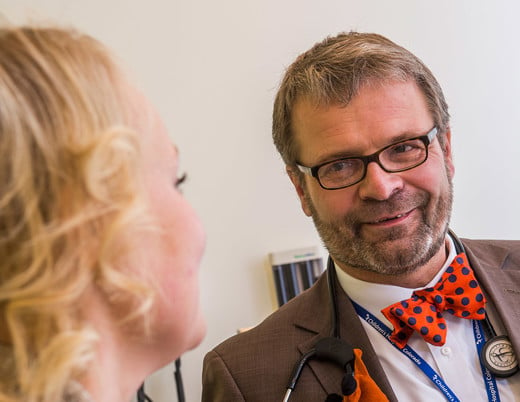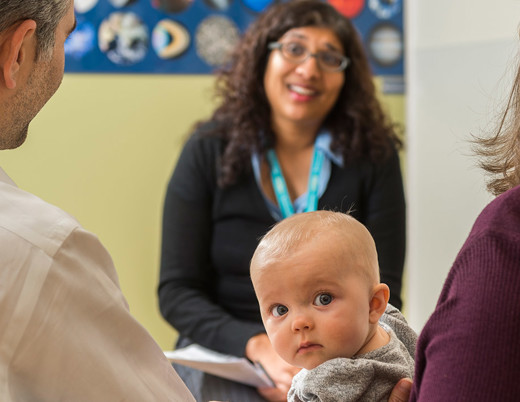A baby is born with hypoplastic left heart syndrome. Within days, she'll undergo the first operation, the Norwood, one of three open heart surgeries needed to survive with a single ventricle. Like any open-heart surgery, the Norwood carries a risk of ischemia — and where there's ischemia, there's a risk of acute kidney injury, or AKI. A group of cross-institutional researchers is finding the ramifications might range wider and deeper than anyone suspected.
"In any given intensive care unit, about one in four patients has AKI," says pediatric nephrologist Danielle Soranno, MD. "And that's probably an underestimate, because the symptoms are subclinical, so many of these cases we probably don't catch. But the consequences can be severe."
An injured kidney retains fluid. The resulting overload can injure the heart. An injured heart can't pump as effectively, leading to blood congestion, which further injures the kidney.
Even the drugs used in post-operative care can compound the damage. At Children's Hospital Colorado, an electronic medical record alert system identifies no less than 57 medications known to injure the kidney.
The vicious cycle of acute kidney injury
All that adds up to a potentially devastating vicious cycle for a neonate with a heart already chronically underequipped for its task.
"Kids sometimes end up needing a heart and kidney transplant simultaneously," says pediatric cardiac intensivist Katja Gist, DO, one of just a handful of cardiologists in the country investigating the interface between kidney and heart. "I've seen that happen several times."
"AKI is not just a complication," says Sarah Faubel, MD, Professor of Nephrology at the University of Colorado School of Medicine and former Chair of the Acute Kidney Injury Advisory Group for the American Society of Nephrology. "It's a disease in itself. The mortality rate overall is around 20%. On dialysis and in intensive care it's more like 50 to 60%."
Linking systems of acute kidney injury
Working with animal models of AKI, Drs. Soranno and Faubel are finding it affects almost everything: the lungs, heart, liver, even the spleen. One of its more disastrous effects is immune dysfunction.
Kids who undergo the Norwood and develop AKI are three and a half times more likely to get a post-surgical infection, independent of other factors, Drs. Gist, Soranno and Faubel found. They published their results in Pediatric Nephrology last fall. In Children’s Colorado's Pediatric Kidney Injury and Disease Stewardship program, or PKIDS, they collaborate with neonatologist Jason Gien, MD, to study AKI in intensive care through a large bank of blood and urine samples collected from every consenting patient across Children’s Colorado's three ICUs.
The effort, however, is campus-wide. Wrapping in pediatric and adult specialists from neonatology, cardiology, surgery, anesthesiology, pulmonology, infectious disease and critical care, the Multidisciplinary Translational Research in Acute Kidney Injury Collaborative, or M-TRAC, acts as a research umbrella across institutions. And their retrospective studies of AKI suggest the long-term consequences may be even farther flung: stroke, blood clots, fractures.
"If you're going to make these associations, they should work in mice, in neonates, in kids, in adults," says Dr. Faubel. "We're trying to make those links among all these different populations."
The cost of acute kidney injury
Patients who sustain even one episode of AKI spend more time in the hospital, more time on ventilators, more time in intensive care. One study estimated the additional hospital cost at $70,000 — and that doesn't even account for the long-term, system-wide consequences.
"It's actually safer to have a heart attack," says Dr. Soranno. "And we've probably seen just the tip of the iceberg. We haven't even looked at the big picture data."
That's not because the data isn't there. Continuous renal replacement therapy (CRRT) machines, standard in ICUs, offer vast, largely unexplored repositories of information. The electronic medical record, too, offers reams of longitudinal data just waiting to be parsed. The question is how to parse it.
Leveraging Health Data Compass
"Five years ago, if a researcher wanted to compare EMR data from UCHealth and Children's Colorado, they'd have to submit two different requests to both institutions, manually curate the data and then do the analysis," says Sarah Davis, principal informatics analyst for Health Data Compass, a company set up on the Anschutz Medical Campus to do just that.
"For physician researchers, that would take all of our lives," says Dr. Faubel. "For them it's just more code."
Soon, that code will pull de-identified EMR data from Children's Colorado, University of Colorado systems and public health records to flow everything from patient history to electrolyte levels to CRRT effluent into a convenient dashboard for M-TRAC researchers. Led by Dr. Soranno, it's been the largest-scale project in Health Data Compass's five-year history.
"We gave them a huge document of variables and variables and variables," says Dr. Soranno. "The database searches diagnostic codes, so we had to come up with literally hundreds of definitions. It really was tedious. But that was where the collaboration really paid off. Everyone got a chance to include what they wanted. We came up with 300 variables altogether."
Launching an acute kidney injury database
"A lot of it is flow sheet data," says Davis. "So, for example, you could enter heart rate into the flow sheet every ten minutes and have minute-by-minute tracking of all these outcomes. It's a great way to capture complex data elements over time. But the scope was definitely challenging."
"It's our hope and expectation that this will be the biggest critical care and nephrology research database in the world."
- DANIELLE SORANNO, MD
The background work complete, it's still a few months from coming online. The next stage is to assess the database's accuracy by manually pulling records and comparing them against its returns. It's a huge data set, and Davis expects bugs. Fine-tuning the algorithms is just part of the process.
M-TRAC researchers are already analyzing the kind of systemic information the database will pull. And they're already finding connections. For example, patients with AKI and elevated chloride levels have nine times the risk of mortality — a life-threatening problem potentially solved by a simple change of fluids. The database will accelerate the pace of those kinds of findings immeasurably.
For patients with chronic, systemic conditions like HLHS — and for almost every patient, child or adult, in every ICU — those findings will save lives. That's exciting. For Dr. Soranno, the most exciting part is what stands to be revealed.
"We don't know what we don't know," she says. "Yet."
Featured Researchers

Danielle Soranno, MD
Pediatric nephrologist
Children's Hospital Colorado
Katja Gist, DO
Pediatric cardiac intensivist
The Heart Institute
Children's Hospital Colorado

Jason Gien, MD
Neonatologist
Neonatal Intensive Care Unit
Children's Hospital Colorado
Professor
Pediatrics-Neonatology
University of Colorado School of Medicine





 720-777-0123
720-777-0123









